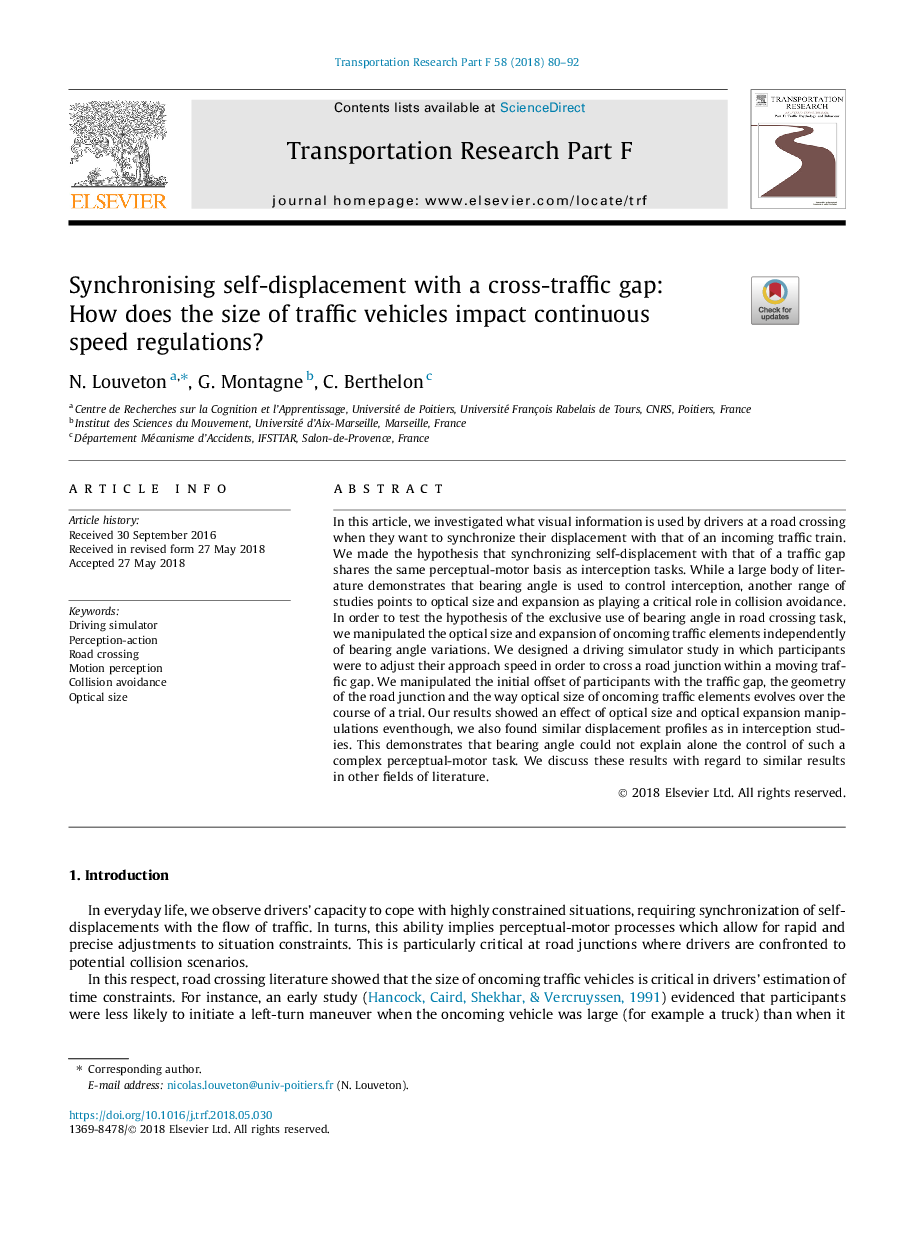| کد مقاله | کد نشریه | سال انتشار | مقاله انگلیسی | نسخه تمام متن |
|---|---|---|---|---|
| 7257480 | 1472429 | 2018 | 13 صفحه PDF | دانلود رایگان |
عنوان انگلیسی مقاله ISI
Synchronising self-displacement with a cross-traffic gap: How does the size of traffic vehicles impact continuous speed regulations?
ترجمه فارسی عنوان
هماهنگ سازی خود جابجایی با فاصله متقابل ترافیک: چگونه اندازه وسایل نقلیه ترافیک تحت تاثیر مقررات سرعت مداوم؟
دانلود مقاله + سفارش ترجمه
دانلود مقاله ISI انگلیسی
رایگان برای ایرانیان
کلمات کلیدی
شبیه ساز رانندگی، ادراک-عمل، عبور جاده، ادراک حرکت اجتناب از برخورد اندازه نوری،
ترجمه چکیده
در این مقاله، ما بررسی کردیم که اطلاعات بصری از سوی رانندگان در عبور از جاده مورد استفاده قرار می گیرد، زمانی که آنها می خواهند جابه جایی خود را همزمان با قطار ترافیک ورودی هماهنگ کنند. ما این فرضیه را مطرح کردیم که هماهنگ سازی خود غیرقابتی با یک فاصله ترافیک، همانند ادراک-موتور، به عنوان وظیفه نگهداری، همکاری می کند. در حالی که یک بخش بزرگ از ادبیات نشان می دهد که زاویه بلبرینگ برای کنترل رهگیری استفاده می شود، محدوده دیگری از مطالعات به اندازه نوری و گسترش به عنوان نقش مهمی در جلوگیری از برخورد کمک می کند. برای تست فرضیه استفاده منحصربفرد از زاویه بلبرینگ در انجام وظیفه عبور از جاده، ما اندازه نوری و گسترش عناصر ترافیکی متقابل را به طور مستقل از تغییرات زاویه بلبرینگ دستکاری کردیم. ما یک مطالعه شبیه ساز رانندگی را طراحی کردیم که در آن شرکت کنندگان برای تنظیم عبور سرعت جاده در یک شکاف ترافیکی حرکتی، سرعتشان را تنظیم کردند. ما با جابجایی اولیه از شرکت کنندگان با فاصله ترافیک، هندسه اتصال جاده و نحوه اندازه اپتیک عناصر ترافیکی متقابل در طی یک محاکمه، دستکاری کردیم. نتایج ما نشان داد که اثر اندازه نوری و دستکاری نوری را نشان می دهد، ما همچنین پروفیل های جابجایی مشابه را در مطالعات مربوط به بازپرداخت یافتیم. این نشان می دهد که زاویه بلبرینگ نمی تواند به تنهایی کنترل چنین کار ادراکی پیچیده را توضیح دهد. ما در مورد این نتایج با توجه به نتایج مشابه در زمینه های دیگر ادبیات بحث می کنیم.
موضوعات مرتبط
علوم انسانی و اجتماعی
روانشناسی
روان شناسی کاربردی
چکیده انگلیسی
In this article, we investigated what visual information is used by drivers at a road crossing when they want to synchronize their displacement with that of an incoming traffic train. We made the hypothesis that synchronizing self-displacement with that of a traffic gap shares the same perceptual-motor basis as interception tasks. While a large body of literature demonstrates that bearing angle is used to control interception, another range of studies points to optical size and expansion as playing a critical role in collision avoidance. In order to test the hypothesis of the exclusive use of bearing angle in road crossing task, we manipulated the optical size and expansion of oncoming traffic elements independently of bearing angle variations. We designed a driving simulator study in which participants were to adjust their approach speed in order to cross a road junction within a moving traffic gap. We manipulated the initial offset of participants with the traffic gap, the geometry of the road junction and the way optical size of oncoming traffic elements evolves over the course of a trial. Our results showed an effect of optical size and optical expansion manipulations eventhough, we also found similar displacement profiles as in interception studies. This demonstrates that bearing angle could not explain alone the control of such a complex perceptual-motor task. We discuss these results with regard to similar results in other fields of literature.
ناشر
Database: Elsevier - ScienceDirect (ساینس دایرکت)
Journal: Transportation Research Part F: Traffic Psychology and Behaviour - Volume 58, October 2018, Pages 80-92
Journal: Transportation Research Part F: Traffic Psychology and Behaviour - Volume 58, October 2018, Pages 80-92
نویسندگان
N. Louveton, G. Montagne, C. Berthelon,
